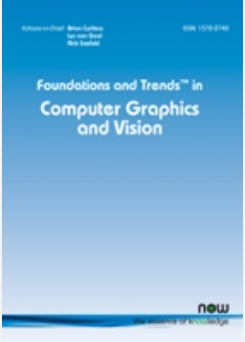3D Reconstruction from Multiple Images: Part 1 - Principles
IF 9.3
Q2 COMPUTER SCIENCE, INTERDISCIPLINARY APPLICATIONS
引用次数: 130
Abstract
This issue discusses methods to extract three-dimensional (3D) models from plain images. In particular, the 3D information is obtained from images for which the camera parameters are unknown. The principles underlying such uncalibrated structure-from-motion methods are outlined. First, a short review of 3D acquisition technologies puts such methods in a wider context and highlights their important advantages. Then, the actual theory behind this line of research is given. The authors have tried to keep the text maximally self-contained, therefore also avoiding to rely on an extensive knowledge of the projective concepts that usually appear in texts about self-calibration 3D methods. Rather, mathematical explanations that are more amenable to intuition are given. The explanation of the theory includes the stratification of reconstructions obtained from image pairs as well as metric reconstruction on the basis of more than two images combined with some additional knowledge about the cameras used. Readers who want to obtain more practical information about how to implement such uncalibrated structure-from-motion pipelines may be interested in two more Foundations and Trends issues written by the same authors. Together with this issue they can be read as a single tutorial on the subject.从多个图像三维重建:第1部分-原则
本文讨论了从平面图像中提取三维模型的方法。特别是,从相机参数未知的图像中获得三维信息。本文概述了这种未经校准的运动构造方法的基本原理。首先,对3D采集技术的简短回顾将这些方法置于更广泛的背景下,并突出了它们的重要优势。然后,给出了这条研究路线背后的实际理论。作者试图保持文本最大限度地自给自足,因此也避免依赖于投影概念的广泛知识,通常出现在文本中关于自校准3D方法。相反,给出了更符合直觉的数学解释。该理论的解释包括从图像对中获得的重建分层,以及基于两个以上图像并结合有关所使用相机的一些额外知识的度量重建。想要获得更多关于如何实现这种未校准的运动结构管道的实用信息的读者可能会对同一作者撰写的另外两个基础和趋势问题感兴趣。和这个问题一起,它们可以作为一个关于这个主题的教程来阅读。
本文章由计算机程序翻译,如有差异,请以英文原文为准。
求助全文
约1分钟内获得全文
求助全文
来源期刊

Foundations and Trends in Computer Graphics and Vision
COMPUTER SCIENCE, INTERDISCIPLINARY APPLICATIONS-
CiteScore
31.20
自引率
0.00%
发文量
1
期刊介绍:
The growth in all aspects of research in the last decade has led to a multitude of new publications and an exponential increase in published research. Finding a way through the excellent existing literature and keeping up to date has become a major time-consuming problem. Electronic publishing has given researchers instant access to more articles than ever before. But which articles are the essential ones that should be read to understand and keep abreast with developments of any topic? To address this problem Foundations and Trends® in Computer Graphics and Vision publishes high-quality survey and tutorial monographs of the field.
Each issue of Foundations and Trends® in Computer Graphics and Vision comprises a 50-100 page monograph written by research leaders in the field. Monographs that give tutorial coverage of subjects, research retrospectives as well as survey papers that offer state-of-the-art reviews fall within the scope of the journal.
 求助内容:
求助内容: 应助结果提醒方式:
应助结果提醒方式:


